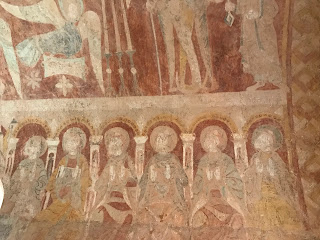. As you walk down the nave, you step on the ghost of Ralph Wootton, a London coachman born in Cheshire in 1652. The question that immediately springs to mind how comes a London coachman get a prime burial spot and commemoration to boot in the church nave? A spot of investigation revealed this from the ‘Marriage Allegations’ 1703/4
‘Marriage license allegation for Ralph Wootton of Kempley, aged abt 50 and Joan Maile of Kempley aged abt 69 23 December 1704’ Apart from the considerable age difference and the fact that poor Ralph died just two years later, you wonder about the story of these two people, and you wonder about the history that between them these two people lived through – from the execution of a king, Cromwell, the Restoration, William and Mary, and Queen Anne. Amazing.
But where Ralph and Joan are glamorous mysteries, the small and unobtrusive plaque above, and what it represents, is beyond sadness. The Great War plucked carpenters and ploughboys from obscure villages like Kempley, their bodies never returned. These are the forgotten men—but not in Kempley.
Fred Dyer
In 1889, Frederick (standing) became the first born and only son of six children wo William and Sarah Dyer, of the lower house, Kempley. As Corporal (Gunner) in the Royal Garrison Artillery, his service took him as far away as India where, in Peshawar, near the very end of the war he died of Pneumonia.
Bill Hodges grew up in Stonehouse Cottage, Kempley. He served in the Hereford Regiment, and served on the fields of Flanders and France. He lived to be the oldest of the nine sons, dying of pneumonia aged 32 in Flanders 1918.
Henry Charles Jones
Born in 1895, one of eight children, Henry’s mother ran the grocer’s shop at Rose View Cottage on Kempley Green. He volunteered in 1914 and joined the King’s Shropshire Light Infantry. Lance Corporal Henry Jones aged 22 lost his life in Flanders 1917.
Samuel Kirby
Kempley born and bred, his family home was 1, Stonehouse Oaks home of fellow service man Alfred Manns. Both men perished in the battles at Ypres, in 1915 and 1917 respectively. Sam was 24, his remains unrecoverable. With nothing to bury his name is recorded on the Menin Gate Memorial, Ypres.
Ben Lane
was first a cowman, working his way up to Head Gardener. Enlisting in the South Wales Borderers he served in Egypt and Mesopotamia where he died aged 30 on Valentine’s Day 1917. He is buried in a field at Shurmran Bend in Iraq
Frank Manns joined the South Wales Borderers in 1911. He was killed in action during the Gallipoli landings in April 1915, aged 22. It is likely he was buried at sea because they had not gained any ground to bury him in. His death is commemorated at Helles Memorial, Canakkale.
Bert Powell was born in 1889 lived in the southern end of Kempley. With his neighbour, Henry Jones, he joined the King’s Shropshire Light Infantry in Hereford and served on the Western Front where he died aged 26. His grave lies in Laventie at the Rue-Du-Bacquerot No 1 Military Cemetery. Reading this, the hopeless sadness of the photographs put me in mind of an old but favourite poem
Elegy in a Country Churchyard
The men that worked for England
They have their graves at home:
And birds and bees of England
About the cross can roam.
But they that fought for England.
Following a falling star,
Alas, alas for Englan
They have graves afar.
And they that rule in England,
In stately conclave met,
Alas, alas for England
They have no graves as yet.
GK Chesterton
I particularly liked the barbed final lines.












No comments:
Post a Comment